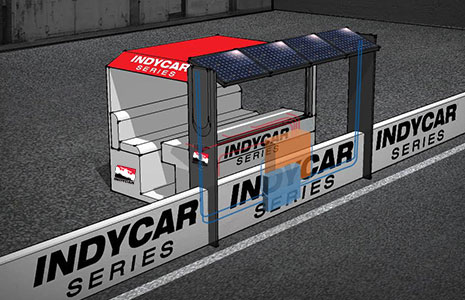Stefan Wilson’s bid to race in the 100th Running of the Indianapolis 500 Mile Race presented by PennGrade Motor Oil is all about combining passions.
Wilson recently signed a sponsorship deal with the American Solar Energy Society, the latest development in his mission to intersect Indy car racing and solar power.
“This is something that I’m hugely passionate about and I’m really excited to be working on it,” Wilson said. “It’s creating an opportunity for me to race at Indy and at the same time I’m actually getting to work with companies that are involved in the solar industry. That is really exciting and really rewarding.”
Wilson, 26, has competed in one Verizon IndyCar Series event, as a teammate to his late brother, Justin, at the Grand Prix of Baltimore in 2013. He also spent three-plus seasons driving in Indy Lights, winning a pair of races on his way to third in the 2011 championship. Now he’s working on a program for this year’s milestone Indianapolis 500 that puts solar power into action.
Wilson has always had an appreciation for conservation, but it wasn’t until 2011, when racing in Indy Lights, that he became interested in solar energy.
“I was always aware of solar conceptually, but I didn’t really know enough about it,” he said. “As I understood it more, how simple it is to capture sunlight and utilize it as an energy source, I realized what a viable solution solar is in powering our energy needs while also reducing the impact we have on the world we live in.
“From there, I started to look around the sport to see where we could really incorporate solar at the racetrack. We might not be able to power the cars yet – and nobody knows if that is where the technology might go – but what can we power?”
 In 2014 Wilson created a video promoting solar energy. It has grown into the #ThinkSolar campaign, which he hopes will bring something new to racing. “A large component of the #ThinkSolar campaign is how we can incorporate solar into the race team now, so I’ve looked at the areas where we use a lot of energy, such as the garage area, the pit lane and the infield.”
In 2014 Wilson created a video promoting solar energy. It has grown into the #ThinkSolar campaign, which he hopes will bring something new to racing. “A large component of the #ThinkSolar campaign is how we can incorporate solar into the race team now, so I’ve looked at the areas where we use a lot of energy, such as the garage area, the pit lane and the infield.”
#ThinkSolar has designed a solar array and energy storage unit that can fit onto an existing pit-lane timing stand (shown at right) and independently power the area where the crew works to analyze data from the car. Teams currently use gasoline-powered generators to power their electronic equipment in pit lane. The solar-powered timing stand is but one example of the way solar energy could benefit the INDYCAR paddock.
Using motorsports to promote a product has been standard practice for decades. Wilson hopes that the solar pit stand will help solar companies reach a different audience in order to generate awareness of the benefits.
“A lot of times when I speak to people, the first thing they say is, ‘Well, it’s a bit ironic that you’re going to try and promote solar clean energy at a racetrack where you are using fossil fuels to power your race car,’” he said.
“At the same time, I think, ‘Why wouldn’t we utilize solar today to offset some of our power needs where we can?’ … The impact of just one INDYCAR fan installing solar on their household as a result of our efforts would completely offset the carbon footprint of my on-track activity in May.
“Many people seem to be aware of the idea of solar energy, but it’s only when you truly get to see, touch and feel the product that you begin to understand that it’s real, it’s viable.”
There is also an educational component to the #ThinkSolar initiative. During Community Day at Indianapolis Motor Speedway on May 25, some 9,000 local students will visit the track – which is already home to a solar field of nearly 40,000 panels that currently provide power to 2,700 area homes. Wilson has approval to host an event that day to showcase solar power for the students.
“It’s really important to educate the next generation about the benefits of solar and the opportunities available to them in the industry,” he said. “Last year, one in 80 jobs were created by the solar industry. The students of today are going to be leading the way in the future. Inspiring them to think solar and potentially consider a career in solar is really rewarding.”